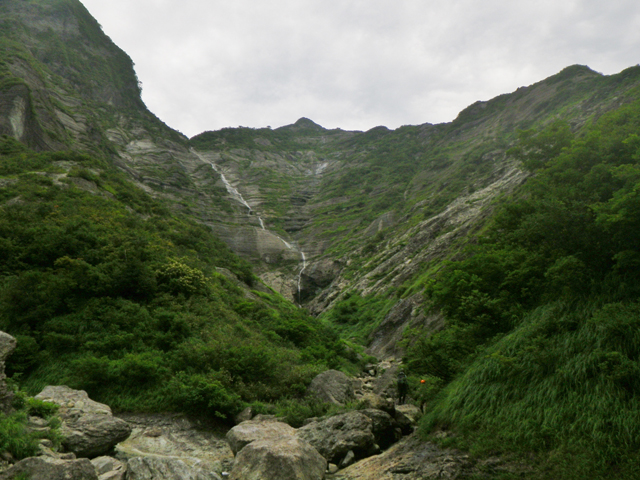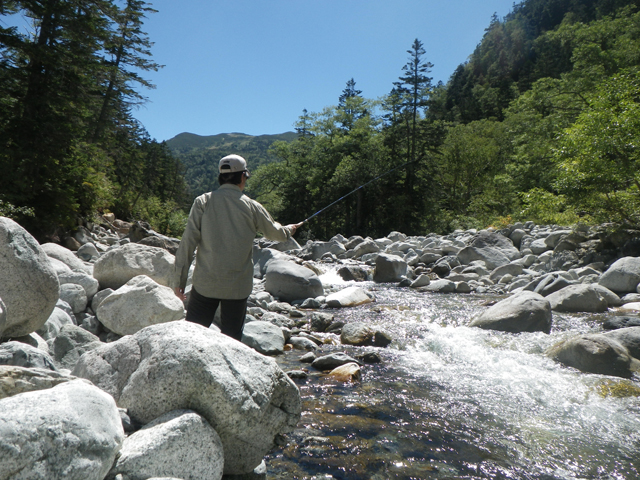Genryu Fishing
“Genryu” is the word that originally means the most upstream part of the river. So, yes, the most upstream part of all the rivers can be called “Genryu”, but when we anglers say “Genryu”, its meaning is somewhat different.
When we say “Genryu” it means the most upstream part of the river also, but it must be in the deep mountains far apart from the towns or villages where people live, and there has not to be car roads or artificial constructs nearby.
Then one and most important thing is it has to be a stream where Iwana (or Yamame in some regions) live. Therefore, “Genryu” is the headwater flowing through the remote areas DEEP in the mountains.
We drive a car for many hours from the town and go into the mountains taking dirt forest roads to the place we have to park a car, then we must walk through narrow trails or climb over a mountain ridge.
Only then do we finally reach “Genryu”.

“Keiryu” means “Mountain stream”. It includes “Genryu”, but Keiryu covers a wider range of flows of mountain streams. For instance, a mountain stream that has a car road alongside it is “Keiryu”. If there are some houses near by the stream, it is called “Keiryu”. If we park a car by the stream and fish right down there, we can say we do Keiryu fishing, but it never be called Genryu fishing.
I live in a city called Mito. It is about 100km north east of Tokyo. The district where I live is called Kanto, and there are many nice mountain streams in the north part of Kanto, but our main Genryu or Keiryu fishing fields are in further north, in Tohoku region. There are so many good mountains and streams in Tohoku. Especially the Asahi mountains spread across Niigata and Yamagata prefectures is our most favorite fishing field. There are beautiful mountains and rich forests that have not changed their appearance for thousands of years.

The main target fish of genryu fishing is iwana in our area. Iwana is the fish with such a strong “upstream running” instinct. It seems that they go up the mountain stream over their lifetime. Sometimes they inhabit surprisingly small streams in very high mountains. So there are no fish living higher than iwana in the mountain streams of Japan.
It was 20 years ago I started keiryu fishing (when I was 30 years old). For the first 1 or 2 years, I fished for yamame in the small mountain streams in the low mountains near my hometown. As my fishing was improved gradually, I began to want to catch bigger fish or more fish. I also wanted to fish for iwana in the higher mountain streams in the deeper mountains. I thought that if I go to the stream in the deeper mountains, I could catch a lot of bigger iwana.
In the beginning, it was a 1 Day fishing, but it became a fishing trip for 1 night and then 2 nights. Fishing staying at local inns or onsen ryokan (traditional inns with hot-spring baths) eventually turned into camp fishing in the stream, and destination streams became more and more remote places in the higher and deeper mountains. Yes, I could catch a lot of large iwana. The streams became the more dynamic flow characteristics of genryu, the mountains were high, the forest was vast and the sceneries became increasingly grand.
Eventually I realised that I did not want to catch lots of big iwana, but I just wanted to fish in the vast and beautiful mountains and nature.
This is why I still go fishing to the genryu today too. Drawing the flow, which I have never seen yet, on my mind. Just like iwana go up the mountain streams over their lifetime, I travel to the genryu seeking for further beautiful flows.Keiichi Okushi – Genryu Addict and Owner of Tenkara-ya
